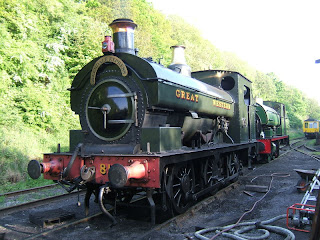 After Santa has left the station: A rainy evening before Christmas at Shackerstone, this year with illuminations.
After Santa has left the station: A rainy evening before Christmas at Shackerstone, this year with illuminations.I think all preserved railways have some form of 'Santa Special' service in December aimed at parents with children. It's satisfying to see packed trains and a delight to see the exitement and awe of the younger visitors. Each railway has developed its own distinctive approach but the event is usually a mixture of a train ride, a present from Santa and mince pies for the grown-ups. So popular has the idea of visiting Father Christmas combined with a train ride become that it's common for preserved railways to take up to one third of their annual turnover in this one month. Handling these passenger numbers with largely volunteer staff puts a tremendous strain on organisations but it's become a vital source of revenue.
For Christmas 2007 I was rostered to do one day on the footplate at the Battlefield Line and a couple of days driving at Peak Rail. At the Battlefield Line, I found that 'Sir Gomer' had been failed and the service train was being handled by visiting B1 'Mayflower' with its own crew so, instead, I spent a pleasant day pottering around the station on 'Linda'.
On normal service days at Peak Rail, 'Royal Pioneer' (Click for pictures) works the service unaided, running round at each end of the line. However, 'Santa Specials' are run 'top and tailed', with a locomotive on each end. This year, because of heavy demand, the load was seven coaches with 'Royal Pioneer' at the Matlock end and a diesel at the Rowsley end. The diesel alternated between the Class 44 'Peak' and a Class 31. There's no 'hooking on' and 'hooking off' during the day and the fireman only has to provide his driver with steam in the 'Up' direction. However, steam heating seven coaches means that the fireman must pay attention to the fire continuously. With 'Royal Pioneer' on the south end of the train, the normal water tank at Rowsley is unavailable, so another tank wagon was positioned on the loop at Rowsley with a portable pump and hose so that the steam locomotive's saddle tank could be replenished during the day.
The turn at Peak Rail on the 2nd December passed without incident, but on the 9th December we discovered that the rostered Class 31 had been failed and so the 'Peak' deputised. During the day, the Class 31 was repaired and it was decided to attach the Class 31 outside the 'Peak' for the last round trip of the day from Rowsley. This meant that, on the last southbound ('Up') service, 'Royal Pioneer' had a gross load over 500 tons. Of course, the 'Up' between Rowsley and Matlock is mainly a gentle descent, with various level and uphill sections, so it wasn't much of a challenge but still produced quite a satisfying 'bark' as the train was got under way. The customary setting of regulator in full first valve linked up a couple of notches on the reverser was sufficient to maintain the scheduled timing.





































